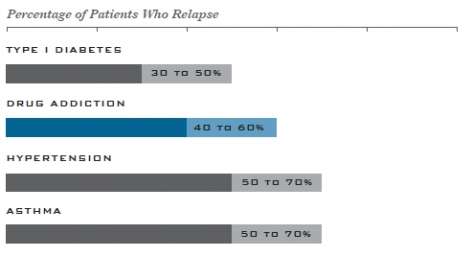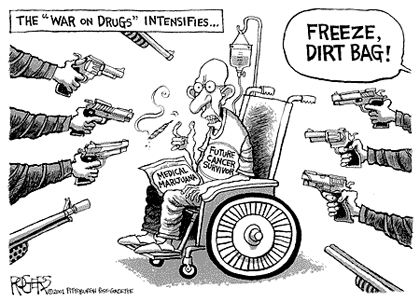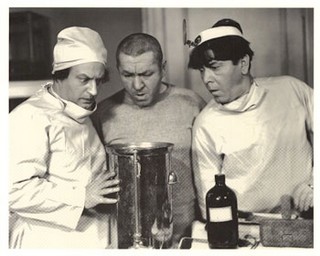
New studies[1] show that neurological changes are responsible for starting a migraine. This is a huge breakthrough, because as far back as the 17th century it was believed that changes is blood flow were responsible for generation of migraine and the resulting neurological effects, not the other way around. This outdated theory is known as the vascular[a] theory of migraine generation. Most doctors and nurses currently practicing were taught the vascular theory of migraines. Much of the documentation made available to the public still explains migraines using the vascular theory, and much of the documentation on the neurological basis of migraines is restricted to scientific articles and medical journals. We now know that neurological changes are behind all the mechanisms of migraine, from aura to vasodilation[b] to pain. Though there are still many discoveries to be made, we are now pointed in the right direction to make these discoveries.
We now know the brain of a migraineur is different than that of other people. “Exposed to repeated sounds or images, the neuron responses in the cortex of the brain [of a normal person] usually decline over time, but in migraineurs, such cortical activity fails to decline. In fact, in some, the electrical activity even increased.”[2]. The sensitivity that migraineurs experience to normal sights, sounds, smells, and other stimuli is as if their brains have turned up the volume on the world. Instead of tuning out, as most people’s brains normally do, migraineurs’ brains can’t help but stay tuned in.
Moreover, Marina de Tommaso from the University of Bari, Italy found that even between attacks, migraineurs experience pain differently. Using a laser to heat a patch of skin to produce mild pain, she had the migraineur perform distracting tasks such as word games. Distracting the mind while it experiences pain normally causes the pain threshold in a person to rise. Literally thinking about something else should take your mind off the pain and give attention to the task at hand. But in migraineurs, their pain threshold didn’t change. It wasn’t that they couldn’t take their mind off the pain—their brains couldn’t be distracted from the pain as a normal person’s would. “Possibly there is some problem with their attention to a stimulus.”[3]
Not only do migraineurs have hyperexcitable brains, but they have hypersensitive brains as well. When exposed to a magnetic pulse, migraineurs see a flash of light “at a significantly lower power pulse than do nonmigraineurs.”[4] The brains of migraineurs have a lowered threshold and sensitivity to their environment. So not only will the brain overreact to the stimulus, but it will notice the stimulus a lot sooner in the first place. It’s a double-whammy that makes the world that migraineurs deal with a lot more difficult. There are many mechanisms to migraine and not all of them are fully understood. Both the body and head of a migraineur are affected, and it's not just during the headache that migraine mechanisms are active.
Even when not in the headache phase, there are chemical imbalances in neurotransmitters such as Substance P, dopamine, serotonin, and magnesium, to name a few. The average concentration of Substance P in migraineurs is nearly double[c] that of 'normal folk.'[5] The average concentration of serotonin, which is depleted during a migraine attack, is about 25% lower[d] than 'normal' during non-migraine phases.[6] And when given nitroglycerine, a vasodilator used by some heart patients, “a delayed migraine-like headache [resulted] in migraine patients but not in 'normal patients.'”[7] It's not just about getting headaches due to a chemical imbalance. That chemical imbalance is there all the time, and certain events will cause that imbalance to then trip over into a migraine.
External changes, such as change in pressure due to weather or altitude, increase or decrease in stress (both positive and negative), exercise or exertion, too much or too little sleep, bright or flashing lights (especially fluorescent lights and computer monitors), loud or high-pitched noises, strong smells (especially perfume), or medications, internal triggers, such as hormonal changes, a drop in blood sugar levels, reactions to food, craving for nicotine, illness, allergies, or changes in metabolism all can trigger the chemical changes that lead to migraine. There are also pre-existing chemical states, such as decreased serotonin and/or magnesium levels that can make it easier for migraine to occur. Moreover, there are genetic factors such as the mutation in the calcium channel genes that have been found to be responsible for familial hemiplegic migraine.
Sensory input, either from within the body or outside of the body, enters into the pons and wrongly stimulates the trigeminal nerve. The fine branches of the trigeminal nerve supplying input to blood vessels around the outer membrane of the brain (meninges) cause the blood vessels to react. Prior to the headache phase and at the very beginnings of the migraine attack, there is a drop in magnesium levels, which is believed to be a destabilizing factor causing the nerves in the brain to misfire[8] (one theory behind types of visual aura). Magnesium interacts with calcium channels, playing a role in overall nerve cell function: “Low magnesium can result in opening of calcium channels, increased intracellular calcium, glutamate release, and increased extracellular potassium, which may in turn trigger cortical spreading depression.”[9]
Simultaneously, stimulation of the trigeminal nerve leads to the release of serotonin (5-HT) from the dorsal raphe nucleus, which suppresses pain initially. “Serotonin appears to block the peptides involved in over-stimulating nerves and producing inflammation.”[10] But then depletion over the course of the migraine attack results in pain[11]. (Serotonin depletion also causes depression and anxiety, two common prodromal symptoms.) Release of serotonin and norepinephrine (also known as noradrenaline) causes a decline in nerve cell function, and along with dopamine, decreased blood flow in the brain. This decline in nerve cell function begins a process known as cortical spreading depression, where waves of nerve activity move across surface of the menages at a velocity of 2-5mm per minute from the back of the brain to the front. This is the start of the aura phase of the migraine attack. Cortical spreading depression was once sited as just the mechanism behind visual auras (such as floaters or zigzag lines appearing in some migraineur’s vision up to an hour prior to the headache), but it’s now linked to migraine pain as well.
At the same time, increased dopamine activity is observed, which has been connected with such prodrome[12] symptoms. Up to 40% of migraineurs[e] experience prodrome. Prodrome symptoms include mood change, loss of concentration, loss of the ability to verbalize, muddled thinking, irritability, confusion, lack of coordination, social withdrawal, loss of balance, stiff neck, cold hands and feet (peripheral vasoconstriction[f]), loss of appetite, constipation or diarrhea, fluid retention (swelling, edema), fatigue, yawning, increased urination, nausea and vomiting, and food cravings to name a few. Specifically, prodrome symptoms have been associated with increased dopamine activity[13].
Migraine changes continue with a malfunction in the brainstem. This is the part of nervous system that connects the brain to the spinal cord. Within the brainstem is an area called the pons, and it is in this area specifically that the migraine generates[14]. “The pons is an ‘attention center,’ controlling how much notice the brain pays to sensory information.”[15] Migraine affects the trigeminal nerve: the nerve that processes all sensory input. The trigeminal nerve connects the brain stem to the nerves of the head and face. It is the nerve responsible for sensations in the head, scalp, face, and meninges, the protective coating around the brain. The trigeminal nerve enters the brainstem at an area called the pons. Here some of its neurons travel up past a region called the periaqueductal gray matter (PAG), into the rest of the brain. The PAG is a relay station between cortical and brainstem structures and plays a major role in the modulation of pain. It provides signaling to the nerves that conduct impulses from the periphery of the body (all the way to the tips of your fingers and toes) back to the brain. The PAG also influences autonomic[g] and defensive behavioral responses, such as breathing, heart rate, blood pressure and the fight/flight response. Neurons traveling the other direction along the same path from the PAG to the pons create a negative feedback loop, and damp down trigeminal signaling (known as an antinociceptive[h] effect).
Cortical spreading depression activates a set of enzymes that allow the blood-brain barrier, the protective membrane that separates local blood vessels and most parts of the central nervous system, to become leaky. Chemicals such as Substance P and Calcitonin Gene-Related Peptide (CGRP) are leaked from the blood vessels into the membrane, causing inflammation. But this inflammation isn’t widespread. Most migraineurs have a specific ‘spot’ that they can point to on their head where they feel migraine pain. Some people have more than one spot where migraine pain occurs, but typically only one is active during a single migraine attack. That spot is where the meninges is inflamed, as discovered by Dr. Marco Pappagallo of Hopkins Medical Research, using Single Photon Emission Computed Tomography (SPECT). “The images showed bright, diffuse patches—a sign of inflammation—at areas in the meninges that precisely matches where patients said they felt their headaches.”[16] The inflammation of the meninges in migraine causes the sensation of throbbing and the symptoms of nausea, sensitivity to light, sound, smells and movement; the same symptoms that occur as a result of bacterial or viral meningitis, which also has inflammation as one of its mechanisms. But inflammation isn’t the immediate cause of migraine pain. It’s more of a response to migraine pain.
Based on responses from the trigeminal nerve, neuropeptides such as Substance P (SP) and Calcitonin Gene-Related Peptide (CGRP) are leaked from the blood into the meninges causing further inflammation. Substance P, besides causing inflammation of blood vessels, releases serotonin (5-HT) from platelets and increases the permeability of capillaries so that other substances, such as bradykinin, are released into the meninges. Bradykinin, like SP and CGRP, is yet another irritating and inflammatory chemical that stimulates pain-conducting nerves as well. Substance P is also a potent vasodilator, causing the release of nitric oxide (NO) from the endothelium.[i] Nitric oxide, too, causes vasodilatation.
Dr. Joel R. Saper of the Michigan Headache and Neurological Institute in Ann Arbor, Michigan holds the theory that, “people [with migraine] are born with or acquire a disturbance in serotonin function,” involving an insufficiency or abnormality in serotonin itself, a defect in the receptors that permit nerve cells to take up and release serotonin, or an abnormality in the enzymes that destroy serotonin, breaking it down too quickly—one way of starting the chain of events that lead to migraine.[17] There is also evidence that suggests certain people are overly sensitive to the effects of dopamine,[18] which includes nerve cell excitation, and that this sensitivity could trigger events leading to migraine.
In fact, most of the migraine-stopping medications like Imitrex and Relpax are artificial serotonin molecules. During a migraine, the body dumps its supply of serotonin from the brain and the blood, passing it out through the body through urine. Studies have shown that an injection of serotonin stops a migraine. "These headaches," writes Dr. David E. Comings, "are relieved by the injection of serotonin or its precursor, 5-hydroxytryptophan. Blood serotonin drops during migraine headaches. This is followed by an increase in 5-HIAA in the urine. MAO inhibitors, which increase serotonin in the synapses, prevent migraine headaches, and medications that stimulate serotonin receptors relieve the acute pain. Migraine sufferers often report that he headaches stop after they have vomited. Vomiting stimulates intestinal motility and raises blood serotonin."[19] Unfortunately, pure serotonin is harsh on the body, so since the introduction of Imitrex in the 1990, researchers have since been developing gentler forms such as Relpax and the most recent (to date) Frova.
All this neurochemical activity begs the question, why would the body react in such a way that only seems to enhance the problem rather than control it? Why would the body want to increase its pain sensitivity and irritated state? One answer may lie in observing the body’s response to damage: inflammation and tissue repair.
When the body is damaged, such as when you skin your knee, the nervous system responds initially with vasoconstriction. You may have noticed that the area around the scrape goes white at first (more noticeable with thermal burns—that is burns from hot or cold; not sun burns, which are caused by UV radiation). Then the area around the most damaged tissue then becomes inflamed, turning bright red as a result of localized vasodilatation. Increased blood flow to the area also causes the area to heat up, and forces fluid out of surrounding tissues resulting in swelling (edema). Mediators of inflammation are released to drive and control the healing process. Some of these inflammation-mediation chemicals may sound familiar: histamine, serotonin, bradykinin, and nitric oxide. Nitric oxide, besides mediating inflammation, is a free radical that is toxic to microbes and helps prevent infection. In this way, the injury is neutralized and tissue repair begins.
When headache pain starts and the brain reacts, it is responding with the same healing process used for a scrape, burn or infection. But since there is actually no damaged tissue to which to respond, the substances released that would otherwise be helpful instead aggravate the pain process already begun. The process turns into a neurochemical merry-go-round, and since the brains of migraineurs don’t tune out over time and can’t be distracted from the pain, the neurological merry-go-round spins out of control.
How the headache stops is not clearly understood, and very little is written on the matter. It may be that the headache ends once the brain has finished cycling through its “healing” (tissue damage reaction) process. It may be that some mechanism deeper in the brain resolves and ends the headache. No matter what the case, what is known is that even after the headache phase is over, there is still the postdrome phase of migraine wherein abnormal cerebral blood flow and EEG readings can be detected up to 24 hours after the pain stops. More research in this area is necessary. Hopefully someday we will be able to stop migraines as easily as they seem to start.
[a] Vascular – related to the blood vessels
[b] Vasodilatation – the expansion and widening of blood vessels due to relaxation of the smooth muscle in the vessel wall, causing a drop in blood pressure
[c] Nearly double – the actual number was 1.97
[d] About 25% lower – actual percentage was 23.7
[e] I suspect this number is actually a lot higher because I didn’t recognize my own prodrome symptoms until I’d been suffering from migraines for over a decade.
[f] Vasoconstriction – the shrinking and narrowing of blood vessels due to flexing of the smooth muscle in the vessel wall, causing a rise in blood pressure
[g] Autonomic – involuntary
[h] Antinociceptive – increased pain tolerance
[i] Endothelium – a thin layer of cells that lines blood vessels
[1]
Bolay H, Reuter U, Dunn AK, Huang Z, Boas DA, Moskowitz MA, “Intrinsic brain activity triggers trigeminal meningeal afferents in a migraine model,” Natural Medicine 2002 Feb; 8(2): 136-42.
[2]
Phillips H, “All in the Mind,” New Scientist, 21 June 2003: 36-39.
[3]
Pain, vol 101: 25.
[4]
Young W, MD and S Silberstein, “Migraine and Other Headaches,” AAN Press, American Academy of Neurology, 2004, p 67.
[5]
Nakano T, Shimomura T, Takahashi K, Ikawa S, “Platelet Substance P and 5-hydroxytryptamine in migraine and tension-type headache,” Headache, 1993 Nov-Dec; 33(10): 528-32.
[6]
Nakano T, Shimomura T, Takahashi K, Ikawa S, “Platelet Substance P and 5-hydroxytryptamine in migraine and tension-type headache,” Headache, 1993 Nov-Dec; 33(10): 528-32.
[7]
Tepper, Stewart J. MD, Rapport, Alan MD, Sheeftell, Fred MD, “The Pathophysiology of Migraine,” Neurologist, 2001 Sep, 7(5): 279-286.
[8]
“Causes of Migraine,” Nidus Information Services, Inc., http://www.nym.org/healthinfo/docs/097/doc97causes.html,
2001.
[9]
Tepper, Stewart J. MD, Rapport, Alan MD, Sheeftell, Fred MD, “The Pathophysiology of Migraine,” Neurologist, 2001 Sep, 7(5):279-286.
[10]
“Causes of Migraine,” Nidus Information Services, Inc., http://www.nym.org/healthinfo/docs/097/doc97causes.html, 2001.
[11]
Brody J, “Studies Unmask Origins of Brutal Migraines,” The New York Times, October 11, 1988.
[12]
“Migraines and Migraine Management,” MEDCEU, MFI Group Inc., http://www.medceu.com/index/index.php?page=get_course&courseID=1445&nocheck,
2006,
[13]
“Causes of Migraine,” Nidus Information Services, Inc., http://www.nym.org/healthinfo/docs/097/doc97causes.html, 2001.
[14]
Goadsby PJ, “Neuroimaging in headache,” Microscopy Research and Technique 2001; 53(3): 179-187.
[15]
Phillips H, “All in the Mind,” New Scientist, 21 June 2003: 36-39.
[16]
Centofanti M, "Migraine Pain Not Mainly in the Brain," The Gazette Online, The Newspaper of the Johns Hopkins University, May 3, 1999; 28(33).
[17]
Brody J, “Studies Unmask Origins of Brutal Migraines,” The New York Times, October 11, 1988.
[18]
“Causes of Migraine,” Nidus Information Services, Inc., http://www.nym.org/healthinfo/docs/097/doc97causes.html, 2001.
[19]
Comings D, “Serotonin: a key to migraine disorders?” http://findarticles.com/p/articles/mi_m0876/is_n70/ai_15911357/, Summer 1994.
Excludes images used here














